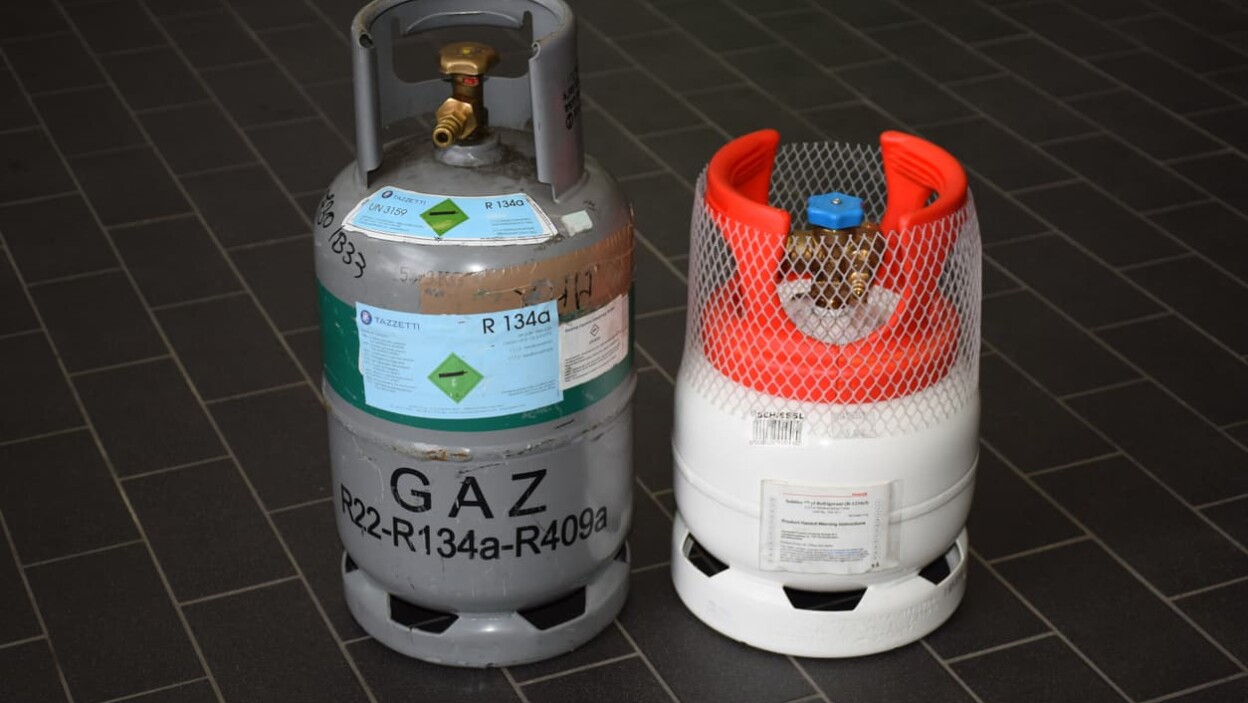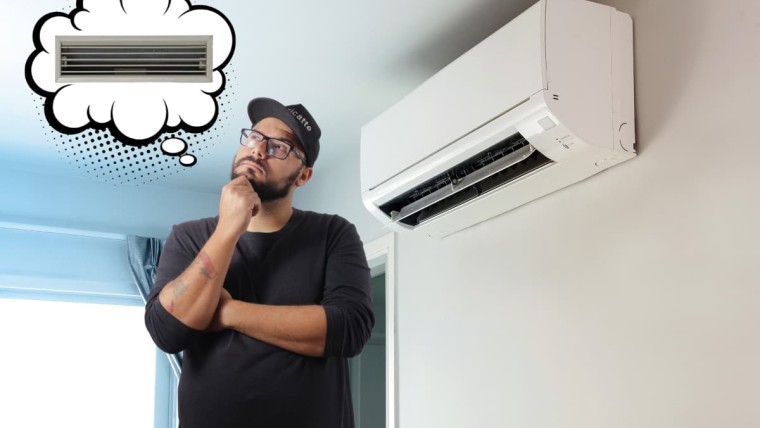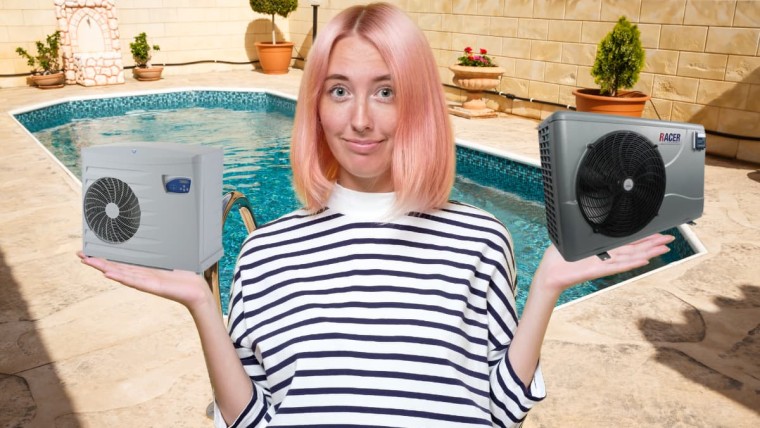For a few years now, the world of heat pumps and air conditioning has been revolutionized by this new gas called R32, replacing R410A. Let's see the differences between these two refrigerant gases and what makes R32 a good candidate to replace R410A.
Here are the main differences between the two gases R32 and R410A:
| R32 | R410A |
| *PRG 675 | GWP 2087.5 |
| Pure gas | Mixture 50% R32 + 50% R125 |
| slightly flammable (A2L) | not classified as flammable (A1) |
| the cheapest | more expensive |
| slightly more efficient | less efficient |
*Global warming potential (characterizes the potency of greenhouse gases)
We will see that both have their advantages and disadvantages, but that the European F-Gas regulation has chosen to limit the GWP for the future, just as it had at the time chosen to abandon HCFCs and R22.
1. R410A has a GWP 3 times greater than R32
The GWP of R32 between 550 and 675 is 3 times lower than that of R410 of 2087.5.
The GWP is the global warming potential. By convention it is expressed in "CO2 equivalent", and the GWP of CO2 is 1.
As a reminder, there are 3 types of refrigerant gases:
- CFCs
- HCFCs
- HFCs
Initially, 65 countries signed the Montreal Protocol in 1987, revised in 1990, which signaled the abandonment of CFCs that were extremely harmful to the ozone layer. For example, R11 and R12 are CFCs with GWPs of 4600 and 10900 ?♂️. Initially planned for 2000, this ban on CFCs was brought forward to 31.12.1995.
These gases are then replaced by HCFCs, such as R22. They are globally less harmful for the environment, with lower GWP on average. The advantage of HCFCs compared to CFCs is that their ODP is negligible (Ozone Depletion Potential = index that characterizes the potential of wear of the ozone layer). R22 is used in many industrial refrigeration or air conditioning appliances in general.
As of January 1, 2010, HCFCs are banned for use. Machines must be serviced with recycled gas only. And since January 1, 2015 it is forbidden to use or introduce HCFCs, even recycled ones, on the market. No more HCFCs.
This was followed by the advent of HFC fluorinated gases, which have no chlorinated molecules, a lower GWP (except for R410A which has a higher GWP than R22), but especially a zero ODP. These gases are R134A, R410A, or R407C. R410A is in many of the most modern machines still today, but it tends to be replaced by the latest F-Gas darling, R32.
The new European regulation of F-Gas, namely n°517/2014 valid since 01.01.2015 has the ambitious goal of reducing greenhouse gases from 80 to 95% by 2050, compared to 1990 data. The ultimate goal is to limit the global temperature increase on the planet to 2°C max.
Specifically in relation to heat pumps and air conditioners, the ban in this Regulation No. 517/2014 concerns bi-block air conditioning systems that contain less than 3kg of gas with a GWP greater than 750, all by January 1, 2025.
Reversible air conditioners for individual housing are directly targeted because they contain less than 3kg of refrigerant in general. Then various heat pumps on the market will also have to evolve following this ban since some contain less than 3kg of R410A whose GWP is well above 750.
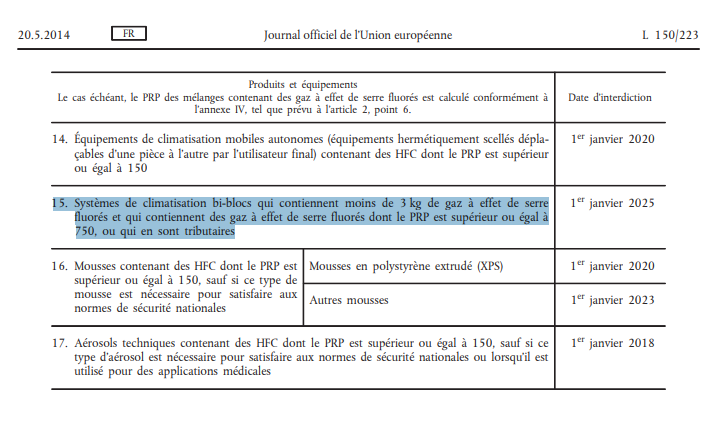
As an example, here is the refrigerant charge of some well-known heat pump references:
| Heat pump model | Fluid type | Fluid load (kg) |
| Daikin Altherma 3 H HT | R32 | 4.2 |
| AQUAREA HIGH PERFORMANCE ALL IN ONE" DUO | R410A | 1.2 à 2.55 |
| NIBE F2120-8 to 20 | R410A | 2.4 à 3 |
| Alfea Extensa Duo 5 to 10 | R410A | 1.1 à 1.8 |
| Alfea Extensa Duo 5 to 10 | R32 | 0.97 à 1.63 |
2. R410A is a mixture while R32 is pure
In fact, R32 is already present in R410A which is a mixture between R32 itself at 50% and R125 at 50%. R32 has the same toxicity class as R410A: it is classified as low toxicity.
3. R32 is slightly flammable, not R410A
A disadvantage of R32 compared to R410A is its flammability and toxicity class according to the NIOSH. Indeed, R32 is classified as A2L which means that it is not very toxic but slightly flammable.

This is not great news as it is planned to be installed in individual housing or ERP.
However, following a modification of article CH 35 of the order of June 25, 1980 by the order of May 10, 2019, it is possible for ERP of cat. 1 to cat. 4 to use flammable fluids provided that a certain number of measures are implemented to control the risk.

4. R32 is cheaper than R410A
R32 is available on the market at prices about 20% lower than R410A.
from a dozen kg, in cylinder, R32 costs 20€ / kg, while R410A costs rather 25€ / kg
Here is the example on an online shop : refrigerantboys.com
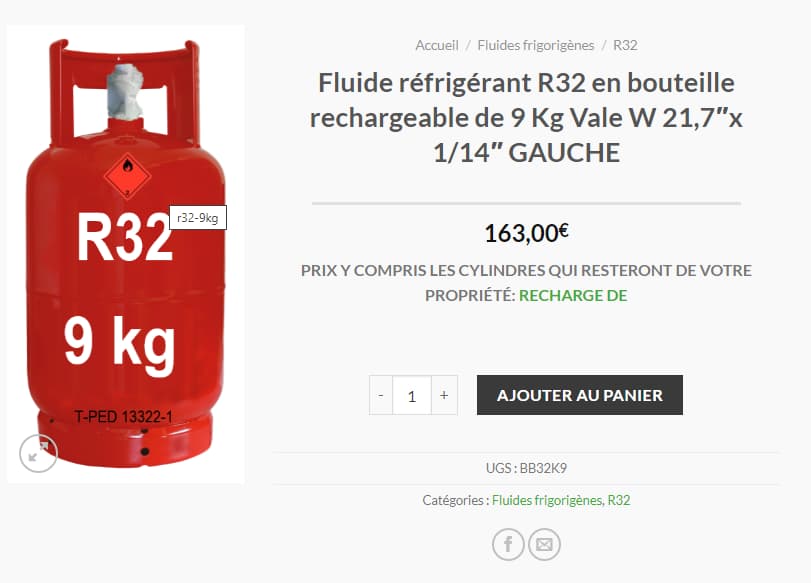
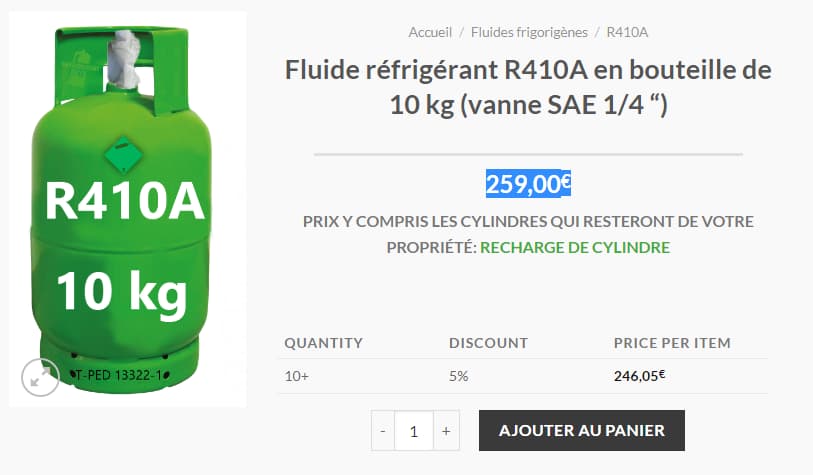
5. For the same power, R32 is more efficient
According to a study conducted by the Center for Environmental Energy Engineering, University of Maryland, USA, and published in 2013The use of R32 in a thermodynamic cycle shows a power of 10% higher and a COP of 9% higher compared to the same cycle with R410A.
R32 is therefore an excellent candidate to replace R410A in air conditioning and heat pump applications
R290: the other natural refrigerant gas that replaces R410A
We talk a lot about R32, which is already present in many new-generation heat pumps from several brands, including Daikin or AtlanticBut other brands such as Sweden's NIBE and Germany's Vaillant, as well as Wolf and Dimplex, have opted for an even cleaner gas. It's a familiar gas, R290, also known as propane.
Very used in cylinders to feed a stove for example, it is a liquefied petroleum gas very resistant to cold, but especially much less harmful for the ozone layer than HFCs since its GWP or PRG is 3 and its ODP is 0. NIBE, Vaillant, Wolf and Dimplex, all European, are thus making the choice in favor of the environment, but there is a but.
Indeed, this very interesting gas from an ecological point of view (and economically since it is worth at the writing of this article less than 2€ per kg), is unfortunately even more flammable than R32, since it is classified A3, i.e. highly flammable according to the NIOSH standard quoted above, and thus requires to take more precautions.
Characteristics of natural refrigerant gas R290 or propane
There is also Stiebel Eltron, the great German heat pump specialist, which has decided to use R454C for its HPAs since 01.01.2021. This gas has a GWP of 148, and excellent thermodynamic properties allowing like R290 to make high temperature up to 75°C.
Conclusion
R32, as a new generation HFC, has many advantages that justify its use to replace R410A. Its major disadvantage lies in its flammability, obliging equipment manufacturers to implement reinforced protective measures to avoid any fire and any disaster that could result from it. Japanese and French manufacturers have opted for R32.
However, the European side prefers R290 or propane because it is more environmentally friendly, but also more flammable. Its thermodynamic properties are very good and are close to those of the very widespread gas that was R22 in its time: what pleases the manufacturers.
Research is constantly progressing, and new gases are already being studied, which could prove to be better than R32 or R290, but this has yet to be confirmed. These include DR-55 and DR-5A gases which are HFO HFC blends. These two would present similar performances to the base gas R410A and would have a much lower environmental impact. In fact the possible smooth candidates that are studied to replace the HFC R410A are on this picture below, but for the moment the two most serious seem to be the DR55 and DR5A. Well this DR55 is not so new since it was revealed by the Chemours company in 2015 at the Yokohama summit. But this study has seriously evaluated the possibility of it replacing R410A and being a rival to R32.
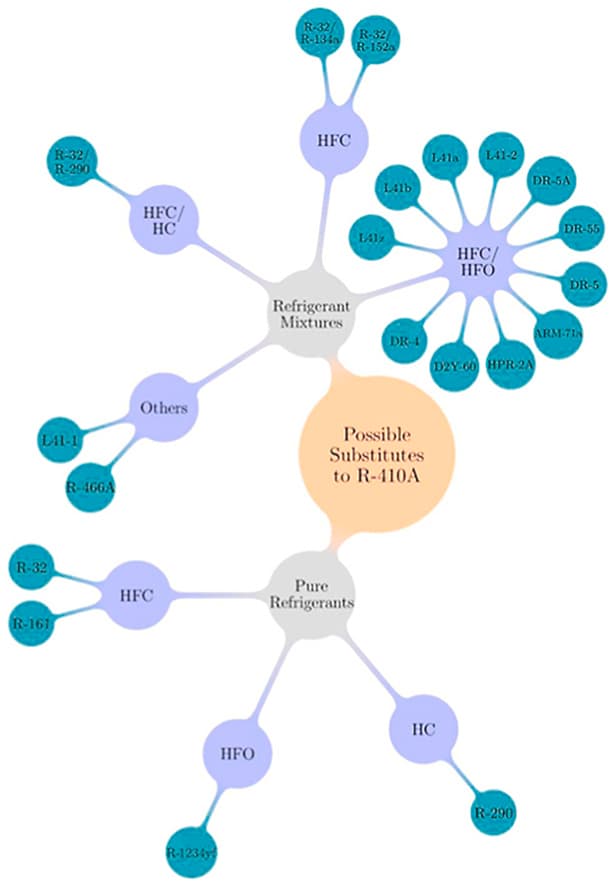
Read more articles about heat pumps :
Opinions on the Daikin Altherma 3H HT
Opinions on the Panasonic Aquarea Heat Pump

Julien G.
Juliena mechanical engineering graduate and specialist in climate engineering since 2009, has become a writer specializing in renewable energies, with expertise in heat pumps and photovoltaic solar panels for individual housing.
See all articles by this author
